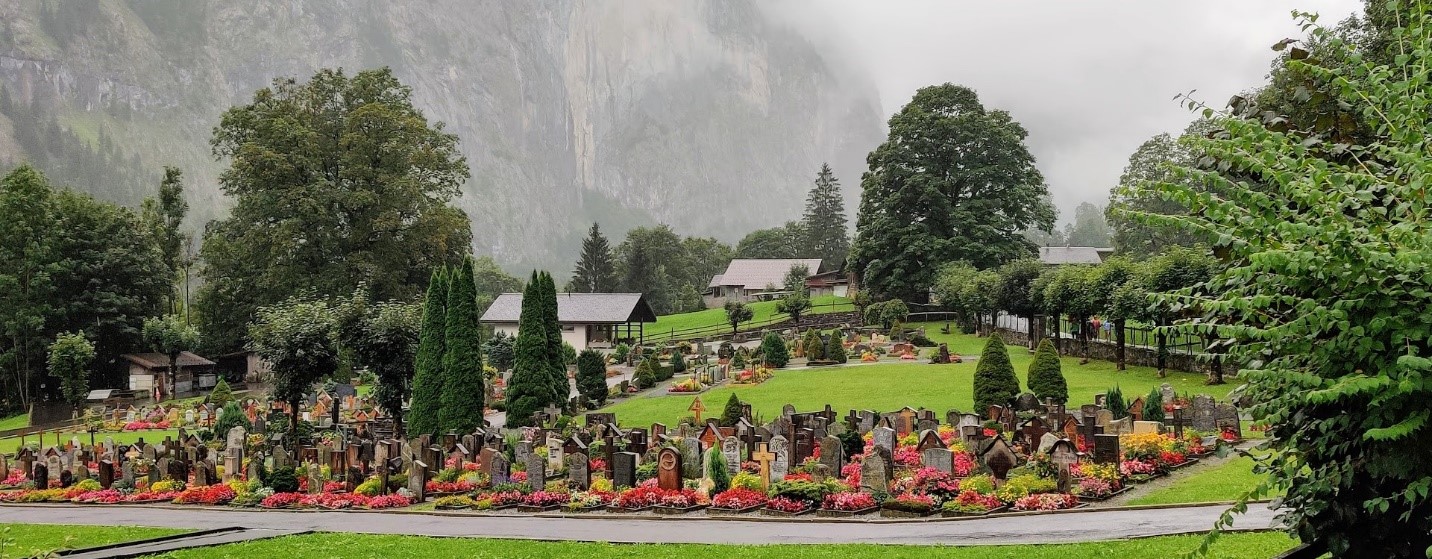Some might ask why I came back from Switzerland with so many pictures of cemeteries. The simple answer is because they are so beautiful, almost as beautiful as the alpine peaks that surround them. The thing that stuck me the most was the vibrant colors of the flowers, all lined up in neat little rows within their own personal flower boxes. After I saw the first cemetery in the Lauterbrunnen Valley, I told my husband that I wanted to be buried in Switzerland. However, once I heard the rest of the story about Switzerland’s cemeteries, I began to change my tune.
On tour

While on a Swiss culinary adventure tour to the medieval town of Gruyères, in the canton of Fribourg, I looked over the castle wall and looked down onto the lovely cemetery of the St. Theodul Church. As I’m looking, the tour guide tells us that this church was built way back in the 13th century. Which made me wonder out loud, why are there so few people buried on the grounds of such an old church? It seems like it should have been overloaded with residents by now? This is where my Swiss tour guide informed me of the quirky truth about Swiss cemeteries.
A relatively small, yet mighty country

As you probably have figured out by now, Switzerland is a small country, under 16,000 square miles with a population of 8.5 million people. This is roughly the size of Vermont and New Hampshire combined (you know, those two US states that you can’t usually name in the Northeast, because they are too small to worry about, and only think about when you want to visit a place to see the beautiful leaves in the Fall). What is a country supposed to do, with millions of people and a shortage of land? Recycle and reuse, of course! It was overlooking this small cemetery in Gruyères that I was enlightened with the fact that in Switzerland, if someone wants to have a loved one buried in a cemetery, they could “rent” the space for up to 25 years. After their times is up, the plot would then be recycled and prepared for the next resident. They do this by either having the graves dug up and consolidated into mass graves, or they are buried on top of each other, with only the headstone changing.
An honorable tribute

When I was in Zermatt, I did come across an exception to this national recycling program. At the church of St. Mauritius, in the center of town, I came across a very moving reminder of the many climbers who have lost their lives while climbing in the Alps. Here I found an entire cemetery dedicated to the climbers who have either lost their lives while trying to summit or descend from one of the many Alpine peaks, or for those made famous for summiting a peak. For me personally, I lost my first husband while hiking, so this was a particularly special place to spend my time. In addition to the “climbers cemetery,” famous people are also given a pass on the Swiss recycling program. For example, the actor Charlie Chaplin and one of our favorite chocolatier’s, Henri Nestlé.
I imagine there are mixed feelings about the way the Swiss manage their cemeteries. Either way, you need to give Switzerland credit for being consistent. The Swiss are known for being orderly, recycling, and living among beauty. I think their cemeteries reflect these very traits.
- What is Schengen? - June 2, 2020
- How to Take a Picture on a Train - January 21, 2020
- Pyramids of Euseigne - December 3, 2019



thank you for the photos & for the history of the cemeteries .So sorry you lost your husband to one of the Alps
Judy